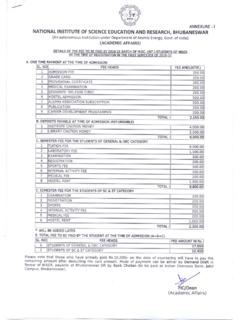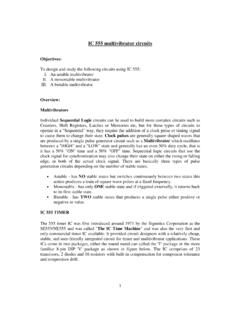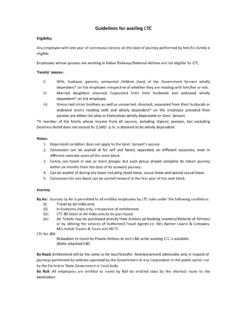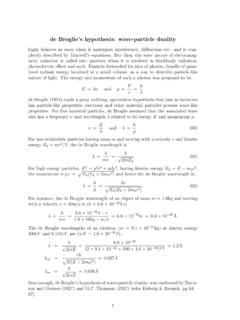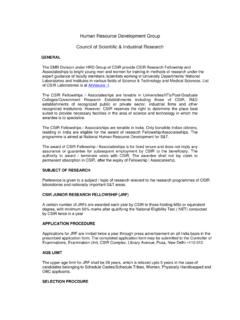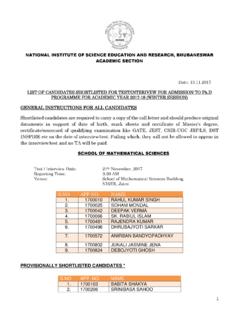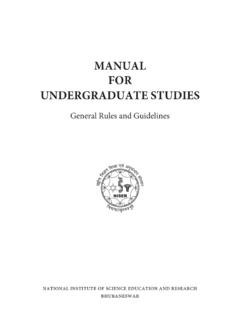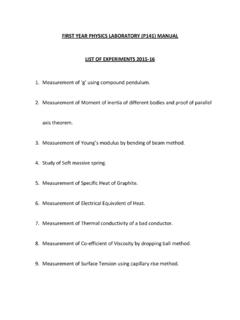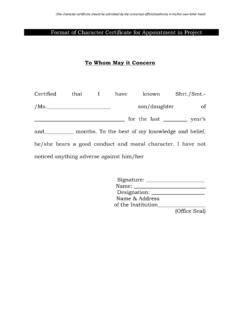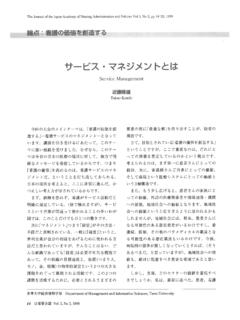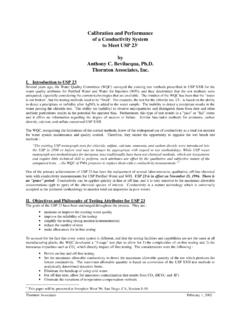Transcription of Gauge symmetry in quantum mechanics - NISER
1 Gauge symmetry in quantum mechanics To understand Gauge symmetry , both local and global, let us go through an extremely concise review of Gauge transformation in classical electrodynamics since it is in that context it appears first. The entire classical electrodynamics in vacuum is described by the following four Maxwell's equations, . ~ E. ~ = Gauss0 s law (61). 0. ~. ~ = B. ~ E. Ampere0 s law (62). t ~ ~. B = 0 (63). ~. ~ = 0~j + E. ~ B. Faraday0 s law, (64). t together with Lorentz force and continuity equation, ~ ~. F~ = q E ~ + ~v B. ~ and + j = 0. (65). t ~ and magnetic field B. The electric field E ~ can be written in terms of scalar and vector ~. potentials ( , A), ~. ~ = . B ~ A ~ and E ~ = ~ A . (66). t However, and A ~ do not uniquely specify E~ and B. ~ There is some amount of arbitrariness in the potentials and if they are transformed in the following manner, ~0 = A.
2 A ~ . ~ and 0 = + . (67). t Maxwell equations describing electrodynamics remain invariant. The transformation of the potentials is called Gauge transformation and invariance of Maxwell equations under Gauge transformation is known as Gauge invariance or the theory of the fields E ~ and B. ~ are said to have Gauge symmetry . is called the Gauge parameter. It has been realized that Gauge symmetry is one of the most desirable symmteries for all sorts of field theory. However in context of quantum theory, Gauge transformation is defined to be change in the phase of the fields, which may or may not depend on the local coordinates. If the phase is constant it is called global Gauge transformation and called local if the phase depends on local space-time coordinates. Presently, the very first step to study is properties of Schr odinger equation under global Gauge transformation.
3 Let (x, t) be the solution of the Schr odinger equation describing motion of a quantum particle in a potential V0 (x). Apply the Gauge transformation, (x, t) 0 (x, t) = ei (x, t), (68). where is the Gauge parameter which is constant. If we substitute 0 for in Schr odinger equation then we get, 0 (x, t) ~2 2 0. i~ = (x, t) + V0 (x) 0 (x, t) (69). t 2m which implies 0 is also a solution of Schr odinger equation and the form of the Schr odinger equation the Hamiltonian remains invariant and so it probability denstiy | |2 = | 0 |2 . 1. Hence we conclude that the Schr odinger equation has global Gauge symmetry . Next thing to address is the invariance of Schr . odinger equation or the corresponding Hamiltonian under local Gauge transformation, which is, (x, t) 0 (x, t) = ei (x,t) (x, t). (70). Now the time and space derivative on 0 will be, 0 0.
4 = i + ei . t t t 0 = i 0 + ei . 2 0 = i 2 0 + 2i ei ( )2 0 + ei 2 . Now assuming 0 is a solution of Schr . odinger equation, under Gauge transformation is no longer one, ~2.. (x, t) 2 (x, t). i~ = [ + i (x, t)] (x, t) + V0 (x) + ~ (x, t) (71). t 2m t and more importantly, the equation (71) is no longer a Schr odinger equation. In other words, Schr odinger equation has no local Gauge symmetry , although | |2 = | 0 |2 still holds. This gives us a clue that Schr . odinger equation in the present form or the Hamiltonian from which it is derived is not Gauge invariant. But if Gauge invariance is demanded then Schr odinger equation requires re-writing by introducing in it space-time dependent functions (x, t) and ~ t) hoping to cancel the unwanted terms as, A(x, (x, t) ~2 h i2. ~ t) (x, t) + [V0 (x) + ~ (x, t)] (x, t). i~ = iq A(x, (72). t 2m Now, if local Gauge transformation (70) is performed then the modified Schr odinger equation ~ and is invarinat under, with A.
5 (x, t) ei (x,t) (x, t). (x, t). (x, t) (x, t) . t ~ ~ 1. A(x, t) A(x, t) + (x, t). (73). q Comparing this with the Gauge transformation in electrodynamics (67), the A ~ and are completely equivalent to standard Gauge transformation of electrodynamics with, A ~ and . being the vector and scalar potentials satisfying Maxwell's equations. This is a spectacular conclusion local Gauge symmetry of Schr odinger equation demands presence of em-fields and charge q! 2.
